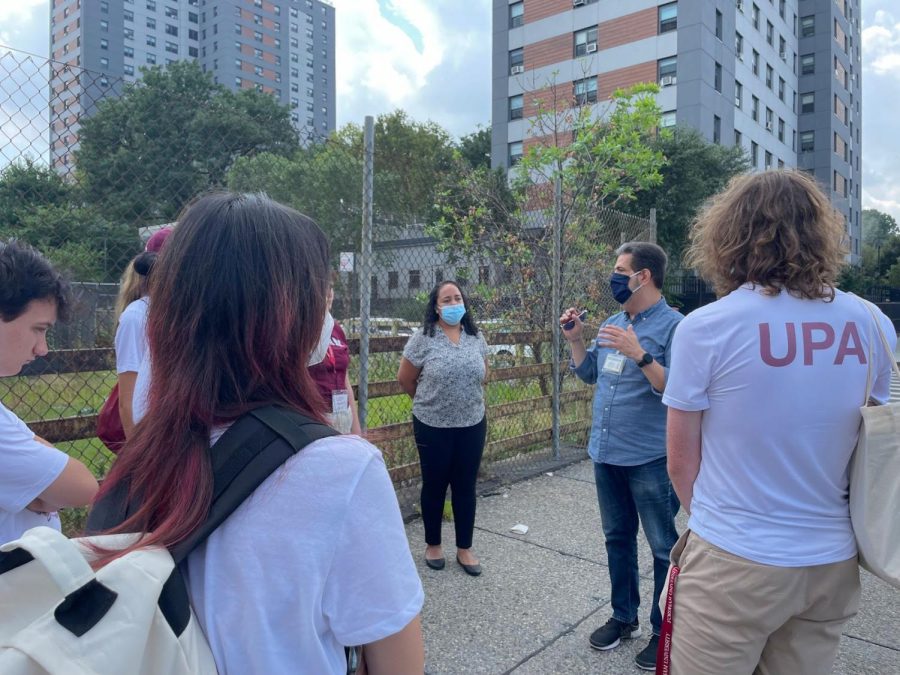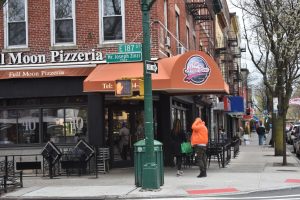Fordham CCEL Joins NYC Mayor in Bronx Federal Study
The landmark federal study aims to address the Cross Bronx Expressway’s pollution effects on the South Bronx and its residents
COURTESY OF ABIGAIL LO
NYC Department of Health officials speaking with Urban Plunge participants in August about the Cross Bronx Expressway and its contribution to Bronx residents’ asthma rates, which are the highest of any community in the nation.
January 25, 2023
Fordham’s Center for Community Engaged Learning (CCEL) has partnered with Bronx-elected officials and New York City Mayor Eric Adams to address the Cross Bronx Expressway’s effects on residents and the borough in a $2 million federal grant. The stipend will fund research into rectifying an urban planning design that has caused widespread chronic health issues in the Bronx’s neighborhoods of color and will allow the community to decide how to use the space freed up by the removal of parts of the expressway.
The expressway, which cuts horizontally through the middle of the Bronx, contributed to high levels of noise and air pollution around the South Bronx neighborhood, causing the community to report increased levels of respiratory illnesses and other health issues.
The grant was funded by the U.S. Department of Transportation Rebuilding American Infrastructure with Sustainability and Equity (RAISE) and was submitted by the New York City Department of Transportation, the New York City Department of City Planning and the New York State Department of Transportation with the New York City Department of Health and Mental Hygiene, according to the city’s official press release.
In the city’s press release, Michael Brady, senior vice president of economic development and policy from the Bronx Chamber of Commerce, said that the study will develop a community-driven plan and identify strategies for transportation connectivity and sustainability.
In the city’s press release, Michael Brady, senior vice president of economic development and policy from the Bronx Chamber of Commerce, said that the study will develop a community-driven plan and identify strategies for transportation connectivity and sustainability.
Nilka Martell, founder of Loving The Bronx, an organization tackling social and environmental issues throughout the Bronx, joined Adams, U.S. Representative Ritchie Torres of New York’s 15th district, U.S. Representative Adriano Espaillat of New York’s 13th district, New York City’s Department of Transportation, and CCEL in a press conference held on Dec. 19, 2022.
Adams noted in the press conference that the initiative plans to confront the effects of a stacked highway system following the displacement of thousands of residents and the expressway’s “tearing apart of a vibrant community.” He said the highway’s construction was racist and divided communities of color across the city through displacement.
“The Cross-Bronx Expressway was a scar carved through the heart of the Bronx, turning bustling streets into ghost towns,” Adams said.
“To do environmental justice work well, we can see from this project that we must start with community-led action that puts frontline communities in positions of power.”Julie Gafney, executive director of CCEL
Julie Gafney, executive director of CCEL, said that CCEL was founded in 2018 to “engage every member of Fordham University in community-based work that advances social justice and protects human rights.” She noted that part of the activities CCEL leads include research and course projects that help advance community solutions.
“This is all about partnerships: policymakers and community organizers working in concert and pushing each other toward solutions,” Gafney said. “To do environmental justice work well, we can see from this project that we must start with community-led action that puts frontline communities in positions of power.”
Marie Atendido, Fordham College at Lincoln Center ’24 and vice president of Lincoln Center’s environmental club, said that she believes the reimagining of the Cross Bronx Expressway would be beneficial. She noted that this effort would particularly aid Black and Latine communities in the surrounding area that have been affected by the noise and air pollution the expressway has caused.
Atendido added that the decision should have come sooner and that the delay is an example of environmental racism.
Rohit T. Aggarwala, chief climate officer and New York City Department of Environmental Protection commissioner, noted that the study will evaluate the needs of communities and propose equitable living conditions.
“I just think it’s unfair that specifically people of color with a lower socioeconomic background have been faced with a disproportionate amount of exposure to toxic waste facilities, dumps and pollution,” she said. “They are not only involuntarily placed in areas that put them at higher risk of toxic exposure, but then they are also excluded in spaces such as environmental policy making about their homes and lives.”
Rohit T. Aggarwala, chief climate officer and New York City Department of Environmental Protection commissioner, noted that the study will evaluate the needs of communities and propose equitable living conditions.
The study was created following grassroots movements organized in the area surrounding Fordham Rose Hill. According to Surey Miranda-Alarcon, director of campus and community engagement at CCEL, the center hopes to incorporate relevant feedback in order to address issues near the university’s location in the Bronx.
“One of the priorities of the study is to incorporate community feedback in terms of the process of how (the reconstruction) is going to happen and rethinking what the space that will be created is used for,” Miranda-Alarcon said.
Stephanie Diaz, Fordham College at Rose Hill ’26 and a resident of the Bronx, believes that the study is important in addressing how the levels of pollution have affected the health of citizens of the Bronx. She added that the socioeconomic status of residents living alongside the Cross Bronx Expressway is also a factor of consideration in this conversation.
Diaz noted that the study is a necessary step toward improving the quality of life for residents of neighborhoods surrounding the expressway.
“Most of the people I know who live or have lived in that area have asthma or other respiratory conditions that are most likely because of all the pollution from the Cross Bronx,” she said. “And because most of the people from these areas are from low-income households, they don’t have the funds to move somewhere else, or they simply might not want to leave because of the convenience.”
Miranda-Alarcon noted that CCEL will continue to utilize its resources in order to aid the efforts to reimagine the Cross Bronx Expressway throughout the course of the study.
“We are a well-respected higher education institution in the Bronx, so there is a moral imperative that we have to make sure that the Bronx, our home, also offers livable and dignified conditions for all people that live in the Bronx,” she said.















Dot Bronx • Feb 1, 2023 at 9:09 pm
This is all wonderful….BUT how does Economic Dev. and Bx Chamber of Commerce and our “Leaders” allow the largest Transportation Hubs to keep building in the Bronx without them chipping in for the damage done to the existing and future residents? 2505 Bruckner is an example.